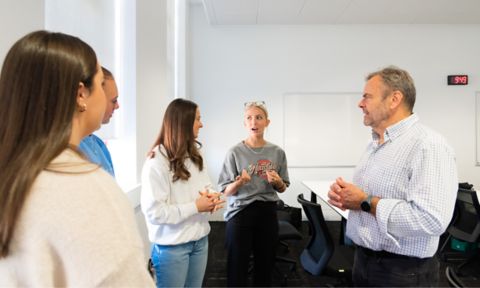In particular, Chinese international students and Australian students with a Chinese background had the unique opportunity to showcase their art skills within the context of their own culture.
Highlights
- Students were asked to produce artwork on the themes of field and encounter. As a public art exhibition, it was intended that the art also reflect the time and space that it was being created in.
- Students were able to practise important art soft skills such as intercultural communication, negotiation, collaboration and trust.
- Seeing students create works of art that extended their own identity and lived experience was a highlight for the educators.
In early 2021, Senior Lecturer Dr Marnie Badham and Associate Professor Dominic Redfern from the School of Art were approached by RMIT PhD student Ye (Sherry) Lui about having Master of Fine Art, Photography and Art in Public Space students participate in the inaugural Huaniao Island Public Art Festival. The opportunity for students to visit the small remote island of Huaniao (a small fishing village a five-hour ferry ride away from the nearest city, Shanghai) to produce custom art pieces for a first of its kind event was too good to pass up. However, the COVID-19 pandemic presented an interesting challenge for both students and educators.
As a public art festival, 10 students were invited to create works of art that reflected and spoke to the place where it was being exhibited and highlighted connection to the site. The project provided a unique opportunity for international students in China who were unable to come to Australia for their studies (due to COVID-19 travel restrictions) to participate in an art residency on the island. However, for students studying in Australia, the 7,000km distance created barriers to understanding the sense of the place they were creating art for. It also meant they couldn’t install their own artwork.
Having to juggle the needs of students in different contexts with different needs to complete their assessment, with the added language barriers, made for an interesting experience for the educators. For Marnie, whose work focuses heavily on socially engaged art and community (art that is responsive to people, community or space), making sure connections to the site and context was achieved through the students’ artworks despite these limitations was a high priority.
“This really challenged students’ willingness to push through complexity and to work within creative limits and restrictions,” Marnie said.
“Students were encouraged to practise soft skills like intercultural communication that we don't often privilege in other classroom context settings. These are important capabilities that they need to succeed in the industry.”
“The art business is half business,” said Dom, “and this festival gave them an opportunity to practise all those skills they will need to succeed.“










